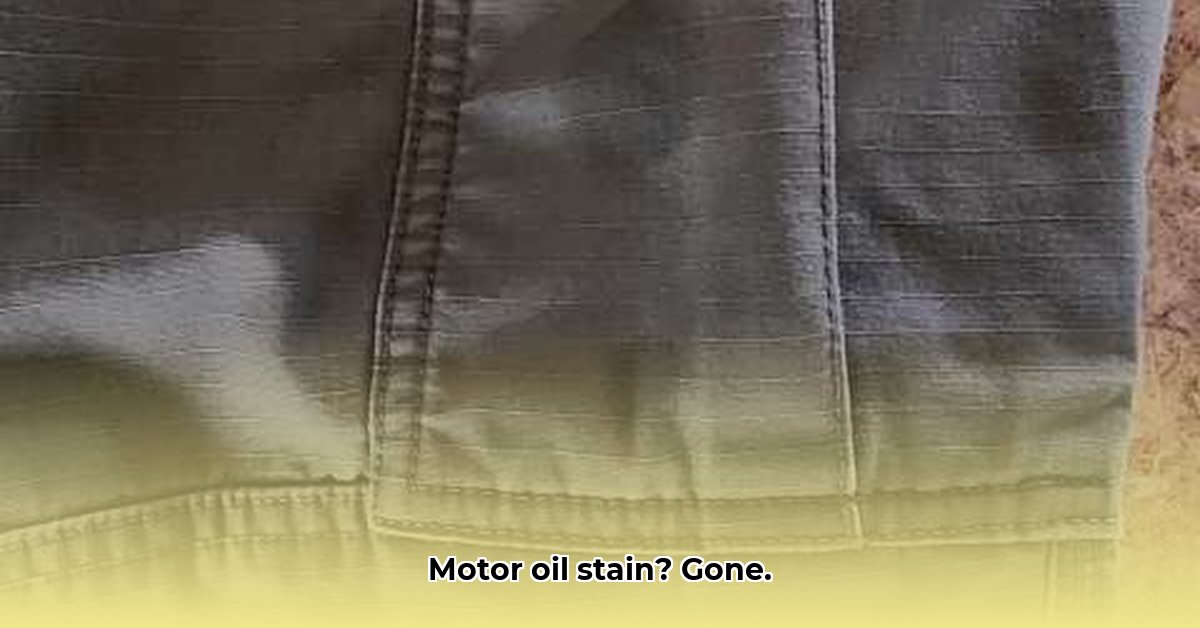Don’t panic! Motor oil stains are a nuisance, but they’re usually conquerable. The key is to act quickly and avoid rubbing the stain, which only worsens it. This guide provides proven methods and expert tips for removing motor oil from various fabrics. Blot, don’t rub – that’s rule number one!
Banishing Oil Stains: Tried-and-True Techniques
Discovering motor oil on your clothes can be frustrating, but with the right approach, you can likely restore your garment. Remember, acting fast and choosing the appropriate cleaning method for your fabric are crucial for success. Whether you’re dealing with a fresh spill or a set-in stain, the following methods offer various solutions.
Household Remedies: Raid Your Pantry and Cleaning Cabinet
Several common household items can effectively tackle motor oil stains. Before reaching for harsh chemicals, try these readily available solutions:
-
Dish Soap/Laundry Detergent: These everyday cleaners are your first line of defense.
- Materials: Dish soap (preferably grease-fighting) or laundry detergent, warm water.
- Instructions: Apply a small amount to the stain, gently rub, let sit for 15-20 minutes, then launder as usual.
- Fabric Considerations: Suitable for most fabrics.
- Pros: Readily available, gentle.
- Cons: May not be sufficient for stubborn stains.
-
Baking Soda/Cornstarch/Talcum Powder: These powders absorb oil like tiny sponges.
- Materials: Baking soda, cornstarch, or talcum powder, soft brush.
- Instructions: Sprinkle generously on the stain, let sit for at least 30 minutes (or overnight), brush off, and launder.
- Fabric Considerations: Safe for most fabrics.
- Pros: Gentle, absorbs odors.
- Cons: Best for fresh spills, may require multiple applications.
-
WD-40: This garage staple can loosen oil stains.
- Materials: WD-40, dish soap, water.
- Instructions: Spray WD-40 on the stain, let sit for 15-20 minutes, apply dish soap, then launder.
- Fabric Considerations: Test in an inconspicuous area first; not recommended for delicates.
- Pros: Effective on stubborn stains.
- Cons: Strong odor, potential for fabric damage.
-
Aloe Vera: A gentler option for delicate fabrics.
- Materials: Aloe vera gel, soft brush.
- Instructions: Apply generously to the stain, gently scrub, let sit for at least an hour before laundering.
- Fabric Considerations: Generally safe for most fabrics.
- Pros: Natural, soothing.
- Cons: Effectiveness may be limited; ongoing research suggests it may work best when combined with other methods.
-
White Vinegar: Deodorizes and helps lift stains.
- Materials: White vinegar.
- Instructions: Add a cup to your washing machine along with your regular detergent.
- Fabric Considerations: Safe for most fabrics.
- Pros: Natural, deodorizing.
- Cons: May not be strong enough for set-in stains.
Heavy-Duty Options: For Stubborn Stains
If household remedies prove insufficient, these stronger methods may be necessary:
-
Shampoo: A surprisingly effective stain remover.
- Materials: Shampoo, warm water.
- Instructions: Mix shampoo with water to create a lather, apply to the stain, rub gently, let sit, and rinse before laundering.
- Fabric Considerations: Suitable for most fabrics.
- Pros: Gentle.
- Cons: May not be effective on heavy stains.
-
Nail Polish Remover (Acetone): A last resort for durable fabrics only!
- Materials: Acetone, cotton balls.
- Instructions: Test in a hidden area first. Apply a small amount to the stain, blot gently, rinse thoroughly, then launder.
- Fabric Considerations: Use with extreme caution. Can damage some synthetics. Avoid on delicates.
- Pros: Powerful solvent.
- Cons: Harsh, flammable, can damage fabrics.
Step-by-Step Stain Removal Guide
Regardless of the chosen method, follow these steps:
1. Act Fast: Treat the stain immediately.
2. Blot: Gently blot excess oil with a clean cloth. Do not rub.
3. Pre-Treat: Apply your chosen cleaning solution.
4. Wait: Allow the cleaner to penetrate the stain (see method-specific instructions).
5. Launder: Wash as usual, using the hottest water safe for the fabric (check the care label).
6. Air Dry: Inspect before machine drying. Heat can set stains. Repeat cleaning if necessary before drying.
Quick Guide: Stain Removal Methods
| Method | Materials | Effectiveness | Fabric Suitability |
|---|---|---|---|
| Laundry Detergent/Dish Soap | Detergent/Soap, Water | Moderate to High | Most fabrics |
| Baking Soda/Cornstarch/Talc | Powder, Brush | Moderate | Most Fabrics |
| WD-40 | WD-40, Detergent | High (for durable) | Durable, Test First |
| Aloe Vera | Aloe Vera Gel, Brush | Moderate | Most fabrics |
| White Vinegar | White Vinegar | Moderate | Most fabrics |
| Shampoo | Shampoo, Water | Moderate | Most fabrics |
| Nail Polish Remover | Acetone, Cotton Balls | High (Risky) | Use with extreme caution! |
Understanding Motor Oil Stains: Why They’re So Stubborn
Motor oil stains are persistent due to their viscosity, the complex mixture of dyes and additives, and their hydrophobic nature (they repel water). This stickiness makes them cling to fabric fibers, and their complex composition makes them difficult to remove with water alone. Understanding the science behind these stains helps us choose the right removal strategy.
Fabric-Specific Care: Tailoring Your Approach
Different fabrics react differently to cleaning methods. Here’s a more detailed guide:
Durable Fabrics (Cotton, Denim, Canvas)
For sturdy fabrics, dish soap and a bit of scrubbing usually do the trick. A vinegar soak can provide an extra boost for stubborn stains.
Delicates (Silk, Wool, Rayon)
Treat delicate fabrics gently with a baking soda paste. A gentle, specialized stain remover can be used if necessary, but always test it on an inconspicuous area first. Dry cleaning is often the safest bet.
Synthetics (Polyester, Nylon, Acrylic)
Synthetics are a bit of a wild card. Always check the care label. Dish soap or a synthetic-specific stain remover might work, but testing is crucial before applying anything.
Troubleshooting and Prevention
- Stain Persists? Repeat the cleaning process or try a different method. A combination of methods might be effective.
- Discoloration? This can occur with stronger cleaning solutions. Test in an inconspicuous area always. Consider color-safe bleach or professional cleaning.
Prevention is the Best Cure:
* Protective Gear: Wear an apron or old clothes when working with motor oil.
* Work Clothes: Keep a dedicated set of “work clothes” for messy tasks.
“An ounce of prevention is worth a pound of cure.” – Benjamin Franklin (While not specifically about motor oil, the wisdom applies perfectly!)
Disclaimer: While these methods are generally safe, we recommend testing any cleaning solution on a hidden area of the garment first. Results may vary depending on fabric type, stain age, and other factors. We do not guarantee specific results. Ongoing research continues to explore more effective and eco-friendly cleaning solutions.
- How to Remove Water Stains from Fabric: A Complete Guide - April 26, 2025
- How to Get Motor Oil Out of Clothes: Proven Methods & Expert Tips - April 26, 2025
- How to Get Deodorant Out of Black Shirts: Easy Stain Removal Guide - April 26, 2025










